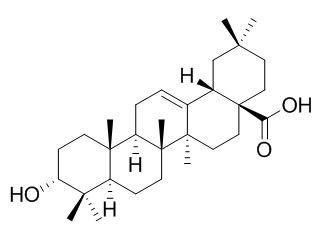3-Epioleanolic acid
3-Epioleanolic acid and oleanonic acid possess varying degrees of agonist activity on uterine smooth muscle with minor changes in the molecular structure affecting its intrinsic activity on uterine muscle.
Inquire / Order:
manager@chemfaces.com
Technical Inquiries:
service@chemfaces.com
Tel:
+86-27-84237783
Fax:
+86-27-84254680
Address:
1 Building, No. 83, CheCheng Rd., Wuhan Economic and Technological Development Zone, Wuhan, Hubei 430056, PRC
Providing storage is as stated on the product vial and the vial is kept tightly sealed, the product can be stored for up to
24 months(2-8C).
Wherever possible, you should prepare and use solutions on the same day. However, if you need to make up stock solutions in advance, we recommend that you store the solution as aliquots in tightly sealed vials at -20C. Generally, these will be useable for up to two weeks. Before use, and prior to opening the vial we recommend that you allow your product to equilibrate to room temperature for at least 1 hour.
Need more advice on solubility, usage and handling? Please email to: service@chemfaces.com
The packaging of the product may have turned upside down during transportation, resulting in the natural compounds adhering to the neck or cap of the vial. take the vial out of its packaging and gently shake to let the compounds fall to the bottom of the vial. for liquid products, centrifuge at 200-500 RPM to gather the liquid at the bottom of the vial. try to avoid loss or contamination during handling.
Molecules. 2013, 18(7):7376-88
Universiti Tunku Aboul Rahman2023, 6263.
Mie University2019, 10076.
J Mol Recognit.2020, 33(2):e2819
J Med Assoc Thai2024, P-04.
Chem Biol Interact.2024, 394:110995.
J Nat Prod.2015, 78(6):1339-4
Applied Biological Chemistry2024, 67:66.
Pharmaceuticals (Basel).2021, 14(6):588.
J Cell Mol Med.2018, 22(9):4236-4242
Related and Featured Products
J Pharm Biomed Anal. 2000 Dec;24(1):133-45.
The uterotonic activity of compounds isolated from the supercritical fluid extract of Ekebergia capensis.[Pubmed:
11108547]
The wood of Ekebergia capensis Sparrm. is used by the local Zulu community in KwaZulu-Natal Province, South Africa to facilitate childbirth.
METHODS AND RESULTS:
In this investigation, the uterotonic properties of extracts from this tree were evaluated using both pregnant and non-pregnant guinea pig uterine smooth muscle in vitro. The extracts were prepared using water modified supercritical carbon dioxide at 400 atm and 80 degrees C. As samples of these extracts displayed positive results when screened for uterotonic activity, gravity column chromatography followed by NMR spectroscopy was performed in an attempt to isolate and elucidate the structures of the compounds that were present in the extract. The extract yielded five known compounds of which only two, viz. oleanonic acid and 3-Epioleanolic acid, displayed uterotonic activity. Receptor binding assays were subsequently performed with 3-Epioleanolic acid to ascertain its mode of action. Bradykinin (30 ng/100 microl) and acetylcholine (1 microg/100 microl) were used as the B2 and cholinergic receptor agonists respectively with icatibant (HOE 140) (30 ng/100 microl) and atropine (60 micro/100 microl) as their corresponding antagonists. 3-Epioleanolic acid was observed to mediate its effect through the cholinergic receptor.
CONCLUSIONS:
The results of this study show that two compounds from the extract of this tree possess varying degrees of agonist activity on uterine smooth muscle with minor changes in the molecular structure affecting its intrinsic activity on uterine muscle.
Phytother Res. 2000 Sep;14(6):463-5.
Antiinflammatory activity and chemical composition of extracts of Verbena officinalis.[Pubmed:
10960904]
METHODS AND RESULTS:
In an attempt to locate the biologically active fraction(s) of the plant Verbena officinalis Linn. (Verbenaceae), a preliminary screening of successive petroleum ether, chloroform and methanol extracts of aerial parts for antiinflammatory activity using carrageenan paw oedema model was carried out.
All three extracts were found to exhibit antiinflammatory activity with the chloroform extract being the most active. Chemical investigations of petroleum ether and chloroform extracts led to the isolation of beta-sitosterol, ursolic acid, oleanolic acid, 3-epiursolic acid, 3-Epioleanolic acid, and minor triterpenoids of derivatives of ursolic acid and oleanolic acids.
CONCLUSIONS:
Chromatographic purification of the methanol extract yielded two iridoid glucosides, verbenalin and hastatoside, a phenylpropanoid glycoside, verbascoside and beta-sitosterol-D-glucoside.



